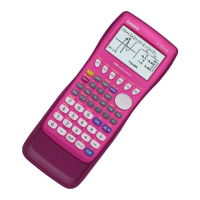190
13-4 Using Dynamic Graph Memory
You can store Dynamic Graph conditions and screen data in Dynamic Graph
memory for later recall when you need it. This lets you save time, because you
can recall the data and immediately begin a Dynamic Graph draw operation. Note
that you can store one set of data in memory at any one time.
The following is all of the data that makes up a set.
•Graph functions (up to 20)
•Dynamic Graph conditions
•Set up screen settings
•View Window contents
•Dynamic Graph screen
uu
uu
uTo save data in Dynamic Graph memory
1. While a Dynamic Graph draw operation is being performed, press A to
change to the speed adjustment menu.
2. Press 5 (STO) to store the data.
• If there is already data stored in Dynamic Graph memory, the above operation
replaces it with the new data.
uu
uu
uTo recall data from Dynamic Graph memory
1. Display the Dynamic Graph function list.
2. Press 6 (RCL) to recall all the data stored in Dynamic Graph memory.
•Data recalled from Dynamic Graph memory replaces the calculator’s current
graph functions, draw conditions, and screen data. The previous data is lost
when it is replaced.
uu
uu
uTo delete Dynamic Graph screen data
1. Press A6 (DEL).
2. Press 1 (YES) to delete the Dynamic Graph screen data, or 6 (NO) to
abort the operation without deleting anything.
P. 189
P. 182
P. 189

